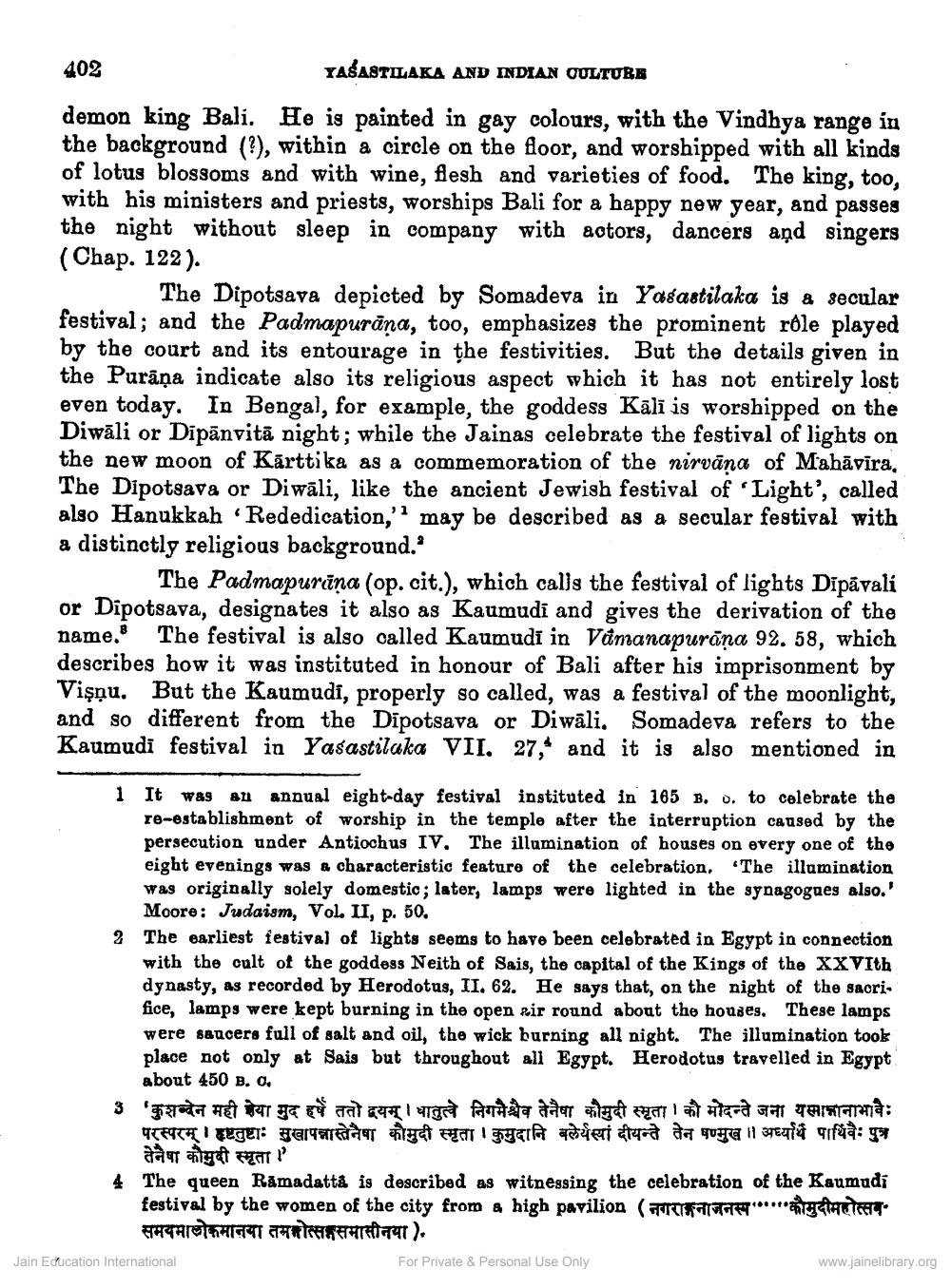________________
402
YAŠASTILAKA AND INDIAN CULTURE
demon king Bali. He is painted in gay colours, with the Vindhya range in the background (?), within a circle on the floor, and worshipped with all kinds of lotus blossoms and with wine, flesh and varieties of food.
e, flesh and varieties of food. The king, too, with his ministers and priests, worships Bali for a happy new year, and passes the night without sleep in company with actors, dancers and singers (Chap. 122).
The Dipotsava depicted by Somadeva in Yasastilaka is & secular festival; and the Padmapurāna, too, emphasizes the prominent role played by the court and its entourage in the festivities. But the details given in the Purāņa indicate also its religious aspect which it has not entirely lost even today. In Bengal, for example, the goddess Kālī is worshipped on the Diwāli or Dipānvitā night; while the Jainas celebrate the festival of lights on the new moon of Kārttika as a commemoration of the nirvāna of Mahāvira, The Dipotsava or Diwāli, like the ancient Jewish festival of 'Light', called also Hanukkah Rededication,'? may be described as a secular festival with a distinctly religious background.'
The Padmapurīna (op. cit.), which calds the festival of lights Dīpāvali or Dipotsava, designates it also as Kaumudi and gives the derivation of the name. The festival is also called Kaumudi in Vamanapurāna 92.58, which describes how it was instituted in honour of Bali after his imprisonment by Vişnu. But the Kaumudi, properly so called, was a festival of the moonlight, and so different from the Dipotsava or Diwali, Somadeva refers to the Kaumudi festival in Yasastilaka VII, 27, and it is also mentioned in
1 It was an annual eight-day festival instituted in 165 B. o. to celebrate the
T8-establishment of worship in the temple after the interruption caused by the persecution under Antiochus IV. The illumination of houses on every one of the eight evenings was a characteristic feature of the celebration, "The illumination was originally solely domestic; later, lamps were lighted in the synagogaes also.'
Moore: Judaism, Vol. II, p. 50. 2 The earliest festival of lights seems to have been celebrated in Egypt in connection
with the cult of the goddess Neith of Sais, the capital of the Kings of the XXVIth dynasty, as recorded by Herodotus, II. 62. He says that, on the night of the sacri. fice, lamps were kept burning in the open air round about the houses. These lamps were saucers full of salt and oil, the wick burning all night. The illumination took place not only at Sais but throughout all Egypt. Herodotus travelled in Egypt
about 450 B. O, 3 'कुशन्देन मही या मुद हर्षे ततो यम् । धातुत्वे निगमैश्चैव तेनैषा कौमुदी स्मृता । कौ मोदन्ते जना यसामानाभावैः
परस्परम् । इष्टतुष्टाः सुखापन्नास्तेनैषा कौमुदी स्मृता । कुमुदानि बलेर्यस्यां दीयन्ते तेन षण्मुख ।। अार्थ पार्थिवैः पुत्र
तेनैषा कौमुदी स्मृता। 4 The queen Rāmadatta is described as witnessing the celebration of the Kaumudi
festival by the women of the city from a high pavilion ( UFATE**** HOT
समयमालोकमानया तमलोत्सासमासीनया). Jain Education International For Private & Personal Use Only
www.jainelibrary.org




